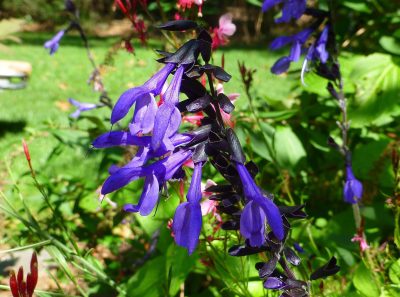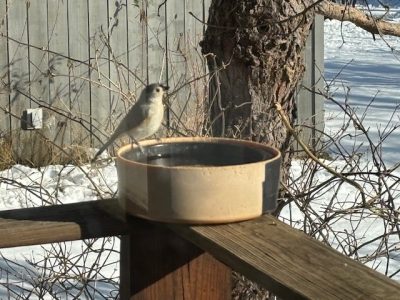By Pamm Cooper, UConn Home and Garden Education Center
Every spring I make a list of the plants that hummingbirds visited the most the year before, and then my search at garden centers and nurseries begins in earnest. The plants I look for are the ones that not only hummingbirds seem to benefit from the most, but also the ones that bloom the longest. I also select the plants whose flowers I enjoy as well.
Although annuals generally have the longest bloom time, there are some perennial ornamentals that are very attractive to hummingbirds and are worth considering for a garden or a landscape. Including a small group of these plants would be a great benefit to hummingbirds as they visit your property.
Obedient plants, Physostegia virginiana, can bloom from early June through September. These drought tolerant perennials may get 3 feet tall and some will slowly spread. If that trait is a problem, The ‘Manners’ series such as the white ‘Miss Manners’ obedient plants are not spreaders. The flowers are also attractive to butterflies, especially tiger swallowtails, and pollinators.
Native swamp milkweed, Asclepias incarnata, is also visited by hummingbirds. This plant likes moister soils than most milkweed, and mine is planted near a birdbath that gets emptied frequently to add fresh water. This milkweed, along with butterfly weed A. tuberosa, can be deadheaded to promote rebloom.
Hyssops, Agastache spp., are also a favorite of hummingbirds, and most have a long bloom period, some starting in late spring. The ‘Kudos’ series with small flowers that are yellow, pink or orange are the ones visited the most by hummingbirds on my property. Another favorite is ‘Boa’, which has larger flower spikes lasting a good three months. Deadheading all will prolong bloom time.
Annual flowering plants that are a favorite of hummingbirds include Salvias, cardinal climber, Fuschias, Lantanas and Cupheas. All are easy to grow, and all but the cardinal vine can be used in containers, hangers and window boxes.
The cardinal climber, Ipomena x multifida, is an attractive, fast-growing annual vine that has small, brilliant red trumpet- like flowers. You can save seeds from this plant and use them next year. One plant can grow to fill a large trellis, and you may need to corral it in if it starts reaching out for nearby plants.
Of the Cupheas, the ones most visited, in my experience, are the large firecracker plant, C. vermillionaire, and the smaller one, C. schumannii, also called the orange cigar plant. The former is superior, with a compact, mounding habit and continuous bloom of orange tubular flowers until frost. If the smaller cigar plant is planted directly in the garden, give it some room as it sprawls somewhat.

Annual Salvias like the “Rockin’ series, the ‘Black and Blue’, ‘Roman Red’ and the ‘Hot Lips’ salvias are the ones I always have in my containers or plant directly in the ground in spaces I leave for them. I would not venture to guess which ones hummingbird prefer, as they visit all of these throughout the day.
There are a couple of shrubs that I learned by chance observance are favorites of hummingbirds. These are Weigelas, and butterfly bushes, Buddleia davidii. There are Weigelas that bloom only in the spring, some that bloom in spring and then again later in the summer through fall, like the ‘Sonic Blooms’, and some that bloom throughout the year, like ‘Crimson Kisses’ and ‘ Peach Kisses’. The last two are smaller shrubs which have a rounded habit.
The plants I have included in this brief article are only a small example of plants that the average gardener can include on their property in gardens or containers of some type. I will mention that while I do have a hummingbird feeder, the hummers I see are favoring actual flowers over that source of food. Downy woodpeckers and orioles do visit the feeder instead, so it is useful to them, I guess. I may start calling it my downy feeder, at least during the summer.
The UConn Home & Garden Education Center supports UConn Extension’s mission by providing answers you can trust with research-based information and resources. For gardening questions, contact us toll-free at (877) 486-6271, visit our website at homegarden.cahnr.uconn.edu, or reach out to your local UConn Extension center at cahnr.uconn.edu/extension/locations.
This article was published in the Hartford Courant July 26, 2025
